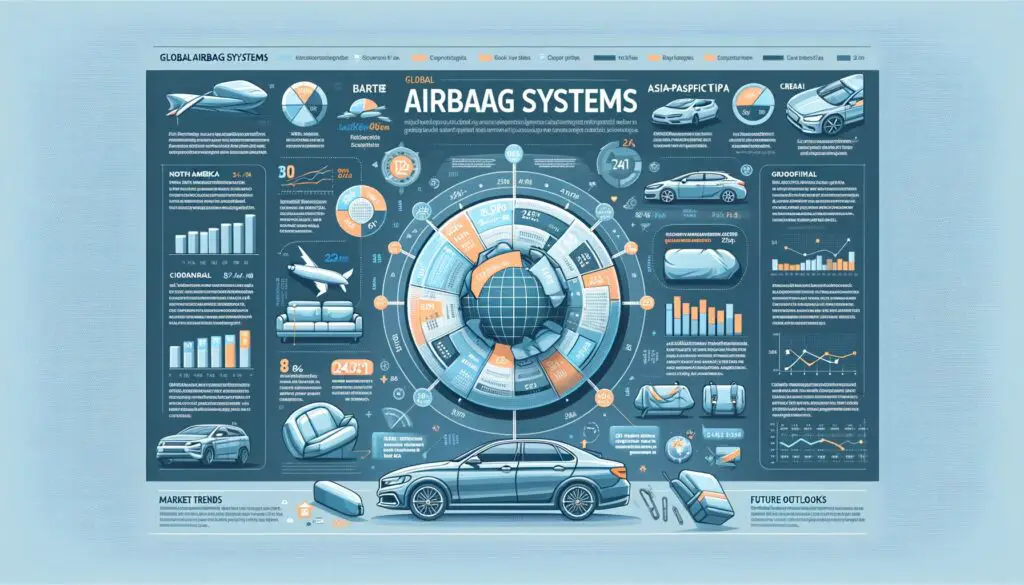In this comprehensive guide, we delve into the evolution and future prospects of airbag systems, exploring their significance in vehicle safety, technological advancements, market landscape, and environmental impact.
Introduction to Airbag Systems
Airbag systems serve as pivotal components in vehicle safety, designed to mitigate the impact of collisions and reduce the severity of injuries sustained by occupants. The historical evolution of airbag technology showcases a remarkable journey marked by continuous innovation and enhancement. From early rudimentary designs to sophisticated, multi-stage airbags, the evolution underscores the relentless pursuit of safer automotive solutions.
Types of Airbag Systems
- Frontal Airbags: Positioned in the front of the vehicle, these airbags deploy during frontal collisions, cushioning the impact for occupants.
- Side Airbags: Installed in the sides of vehicles, these airbags offer protection during side-impact collisions, reducing the risk of injury to occupants.
- Curtain Airbags: Deployed from the ceiling, these airbags provide head protection in the event of a side collision or rollover.
- Knee Airbags: Located beneath the dashboard, knee airbags help prevent lower limb injuries during frontal crashes.
- Rear Airbags: Positioned in the rear of vehicles, these airbags offer supplementary protection in rear-end collisions.
- Center Airbags: Emerging as a newer addition, center airbags deploy between front occupants, mitigating the risk of collision between them.
Understanding Airbag System Components
- Airbag Module: Houses the airbag cushion and inflation system.
- Crash Sensors: Detect collision forces and trigger airbag deployment.
- Inflation System: Utilizes compressed gas to rapidly inflate the airbag upon deployment.
- Control Unit: Processes sensor data and determines the need for airbag deployment.
- Deployment Mechanism: Initiates the deployment sequence, ensuring timely inflation and positioning of airbags.
Advancements in Airbag Technology
Recent advancements in airbag technology have propelled the industry towards greater safety standards and efficiency. Adaptive airbags, capable of adjusting deployment force based on occupant characteristics, ensure optimal protection in diverse scenarios. Multi-stage airbags offer variable deployment strategies, adapting to collision severity for enhanced safety. Pedestrian airbags and inflatable seat belts represent innovative solutions aimed at extending protection beyond vehicle occupants to vulnerable road users.
Key Players and Market Landscape
Leading manufacturers in the airbag systems market play a pivotal role in shaping industry dynamics and innovation. Market share analysis highlights the competitive landscape, with established players vying for dominance alongside emerging contenders. Key trends such as the integration of advanced sensors and materials underscore the industry’s commitment to continual improvement and safety innovation.
Global Market Analysis
The global airbag systems market exhibits robust growth potential, driven by increasing awareness of vehicle safety and stringent regulatory mandates. Market size and growth projections reflect the expanding scope of airbag applications across diverse vehicle segments. Regional market dynamics underscore varying regulatory frameworks and consumer preferences, influencing product development and market penetration strategies.
Factors Driving the Growth of Airbag Systems Market
- Increasing Concern for Vehicle Safety: Growing awareness of road safety issues and the rising incidence of collisions drive demand for advanced safety features such as airbag systems.
- Stringent Safety Regulations: Regulatory mandates mandating the inclusion of safety technologies in vehicles propel market growth and innovation in airbag systems.
- Technological Innovations: Continuous advancements in sensor technology, materials science, and AI contribute to the development of smarter, more effective airbag systems.
Challenges and Opportunities
- Cost Constraints: Balancing safety enhancements with cost considerations poses a significant challenge for manufacturers, necessitating innovative solutions to maintain affordability.
- Integration with Advanced Driver Assistance Systems (ADAS): Seamless integration with ADAS technologies presents both challenges and opportunities, as manufacturers strive to create synergistic safety ecosystems.
- Market Penetration in Developing Regions: Expanding market reach into developing regions requires tailored strategies addressing unique regulatory, infrastructural, and consumer behavior dynamics.
Future Outlook and Trends
The future of airbag systems is characterized by integration with vehicle connectivity technologies, enabling real-time data exchange and predictive safety measures. Smart airbag systems equipped with AI algorithms and predictive analytics hold promise in revolutionizing occupant protection. The shift towards autonomous vehicles further emphasizes the importance of robust safety features, positioning airbag systems as integral components of future mobility solutions.
Sustainability and Environmental Impact
Material innovations aimed at producing eco-friendly airbags underscore the industry’s commitment to sustainability. End-of-life considerations and recycling initiatives ensure responsible disposal and minimize environmental impact, aligning with global efforts towards a greener automotive industry.
Consumer Awareness and Safety Education
Educating consumers on proper seatbelt usage and airbag deployment dynamics is essential for maximizing the effectiveness of safety systems. Clear communication and comprehensive safety campaigns empower individuals to make informed decisions and prioritize safety on the road.
Case Studies and Success Stories
Real-life case studies highlighting the impact of airbag systems underscore their efficacy in preventing injuries and saving lives. Testimonials from survivors offer compelling narratives that emphasize the tangible benefits of advanced safety technologies.
Innovations Beyond Automotive Industry
The application of airbag technology extends beyond the automotive sector, finding utility in aerospace and industrial machinery applications. Adaptations and innovations in diverse industries showcase the versatility and effectiveness of airbag systems in ensuring safety across various domains.
Investing in Airbag Technology: Opportunities and Risks
Strategic market investment in airbag technology presents opportunities for growth and innovation. However, inherent risks such as regulatory changes, technological disruptions, and market volatility necessitate a comprehensive risk assessment and investment strategy tailored to individual objectives and risk tolerance.
Conclusion: Shaping the Future of Vehicle Safety
In conclusion, airbag systems represent a cornerstone of vehicle safety, continuously evolving to meet the challenges of an ever-changing automotive landscape. As advancements in technology and safety standards drive innovation, the future promises even greater strides in protecting occupants and reducing the impact of collisions on roadways worldwide.
Frequently Asked Questions (FAQs)
- How do airbag systems work? Airbag systems deploy rapidly upon collision detection, inflating cushions to cushion occupants and mitigate injury.
- Are airbags mandatory in all vehicles? While regulations vary by region, many jurisdictions mandate the inclusion of airbag systems in new vehicles to enhance occupant safety.
- Can airbags cause injuries? Improper deployment or positioning of airbags can result in minor injuries, highlighting the importance of proper installation and maintenance.
- What are the latest advancements in airbag technology? Recent advancements include adaptive airbags, multi-stage deployment systems, and pedestrian detection features for enhanced safety.
- How do airbag systems contribute to overall vehicle safety? Airbag systems serve as primary passive safety features, reducing the risk of injury to vehicle occupants during collisions.
- Are there any regulations governing airbag installation? Yes, regulatory bodies establish guidelines and standards for airbag installation and performance to ensure consistent safety standards across vehicles.
- What should one do after airbag deployment in a crash? Following airbag deployment, occupants should exit the vehicle if safe to do so and seek medical attention if injured.
- Are airbags recyclable? Yes, many components of airbag systems are recyclable, contributing to sustainability efforts in the automotive industry.
- How do airbag systems differ in various vehicle types? Airbag systems may vary in design and deployment strategy based on vehicle type, size, and intended usage, but the fundamental principle of occupant protection remains consistent.
- What are the future trends in airbag technology? Future trends include integration with vehicle connectivity, development of smart airbag systems, and adaptation to the evolving landscape of autonomous vehicles.
- child presence detection system market share ? Major players in this market include automotive manufacturers, technology companies specializing in sensors and detection systems, and startups focusing on child safety solutions. However, specific market share figures for this niche segment might not be readily available





